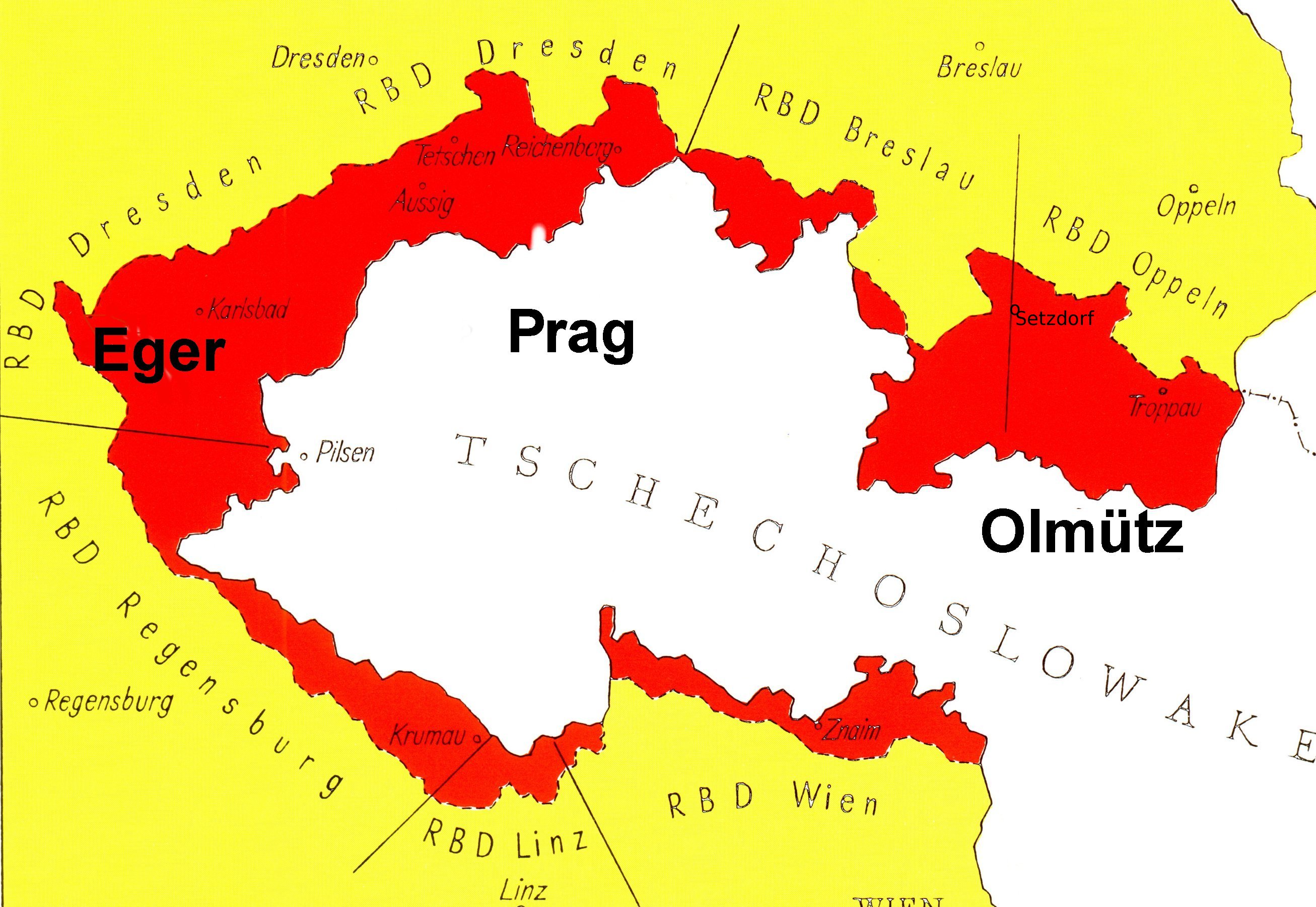 Figure 1: Map of
Sudetenland. Note Eger in the west and Olmütz just south of
Northeast part which includes Troppau and Setzdorf /2/.
Figure 1: Map of
Sudetenland. Note Eger in the west and Olmütz just south of
Northeast part which includes Troppau and Setzdorf /2/.|
© Dr. Artur Knoth |
Brazilian Philately: The Pan Am Zeppelin Flight of 1930 |
Zeppelin Letters to Czechoslovakia/Sudetenland(/1/)
Zeppelin covers got sent to every conceivable destination on the globe. Covers sent to not often seen destinations are not only an interesting aspect for the avid Zeppelin collector, but also for the non-Zeppelin collectors of that specific country. Two covers sent to then Czechoslovakia demonstrate that they can interest several different collector groups simultaneously. These covers have an aspect linking them to the Sudetenland, and thereby of interest for collectors of Germany.
 Figure 1: Map of
Sudetenland. Note Eger in the west and Olmütz just south of
Northeast part which includes Troppau and Setzdorf /2/.
Figure 1: Map of
Sudetenland. Note Eger in the west and Olmütz just south of
Northeast part which includes Troppau and Setzdorf /2/.
In 1930, the Zeppelin undertook one of its most ambitious flights, the famous 1930 Pan American flight that started in Friedrichshafen with stops at Seville, Pernambuco, Rio, Lakehurst and back to Seville and Friedrichshafen. Two covers (Fig.2 and 3) were sent to a person living in Olmütz in Czechoslovakia, by an acquaintance in São Paulo, Brazil. On such famous flights, there are usually tons of covers (the dealers were very active on this flight). The challenge is to obtain covers to not very common destinations and other more "exotic" things that separate them from the run-of-the-mill material usually available. The vast majority of the covers on this flight have destinations either in the USA or the German language area (i. e. Austria, Switzerland and Germany proper). These letters to Czechoslovakia, considering the addressee (Rudolf von Kulmburg) and addresser (H. Meinert), could well be to an individual of the "German" minority.
The following discussion attempts to demonstrate that not obviously German covers can still have aspects that Germany collectors will recognize and find relevant for the philatelic aspects of the Sudetenland.
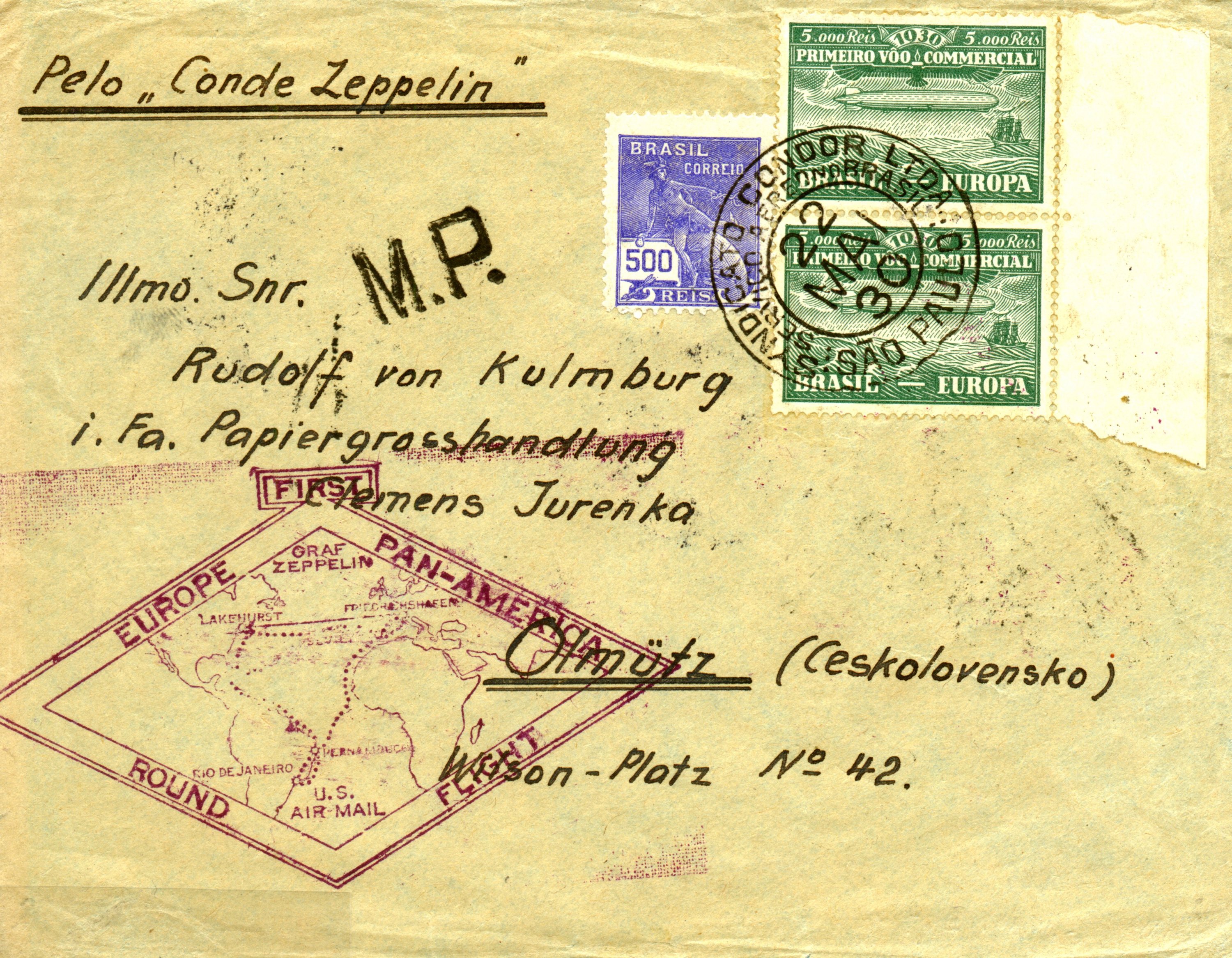 Figure 2: Front of cover to
Olmütz franked with 2 times 5$000 for the letter rate
Figure 2: Front of cover to
Olmütz franked with 2 times 5$000 for the letter rate
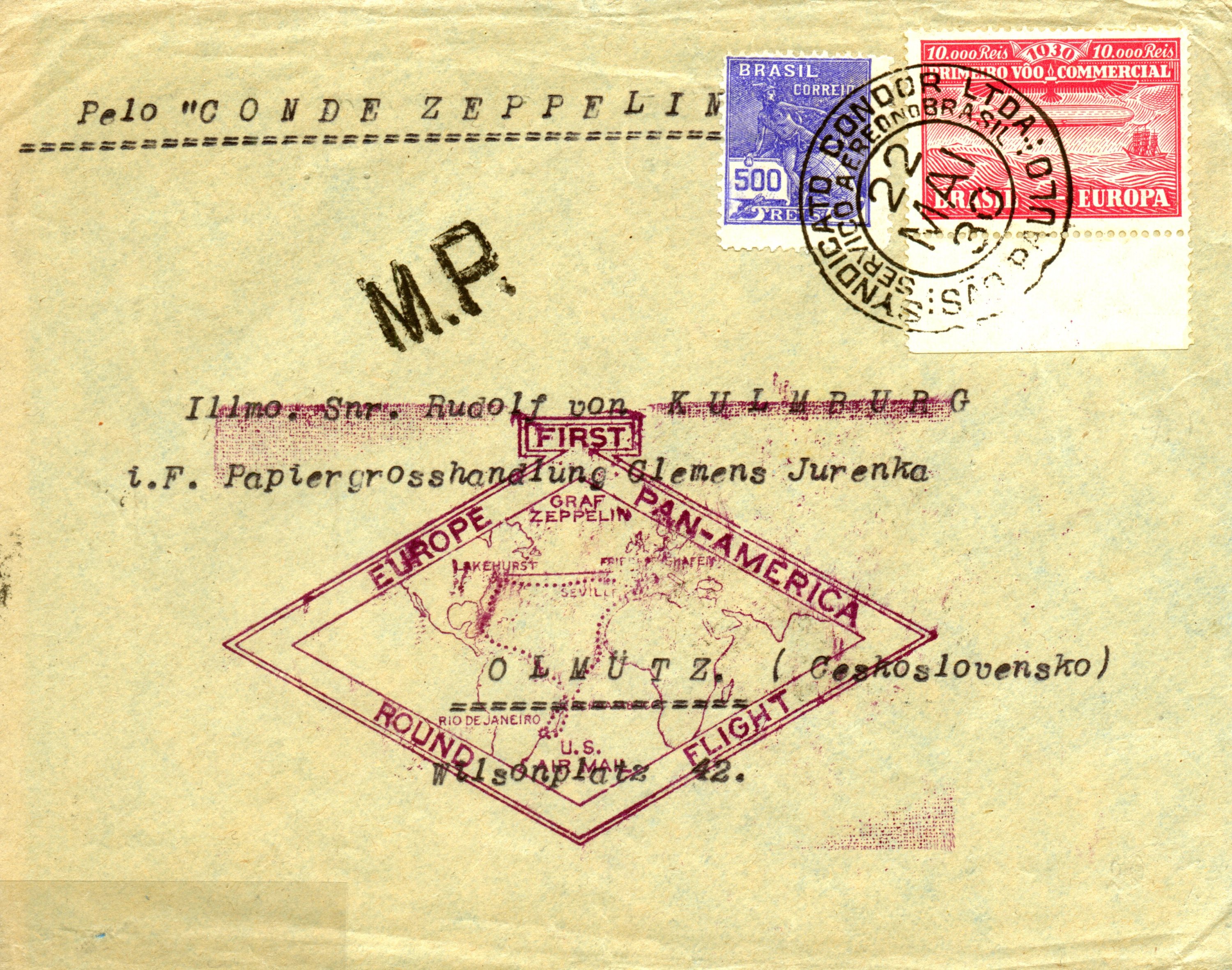 Figure 3: Front of cover to
Olmütz using a single 10$000 franking
Figure 3: Front of cover to
Olmütz using a single 10$000 franking
Stamps: For this flight, Germany even issued the special Zeppelin stamps (Mi. 438,9) with the an inscription for this flight. Dr. Eckener attempted to get the same thing done in the other major countries. In the US he was successful, but had no luck with the authorities in Spain and Brazil, both having more pressing problems. But in the case of Brazil, he received permission to create and use "private" labels for this flight. Thus was born a set of three basic stamps with the denominations of 5$000, 10$000 and 20$000 Reis (Fig.2 and 3). Although the stamps were valid only for this flight and Brazilian mail, the stamps themselves were printed at the Reichsdruckerei on watermarked paper that normally was used in Germany for fiscal purposes (Scott Wmk. 127 - Quatrefoils; Michel Wz. Kreuzblüten – a. k. a. Vierpass).
Rates: Among cover collectors there is always the problem of under-/overfranked covers. In the case of the Brazilian part of the mail, such a chaos ensued that there are two different correctly franked options /3/. Way at the beginning, the rate for letters from Brazil to Germany was 25$000 (i. e. Europe except for Spain which had a rate of only 20$000). But since this was so expensive (and probably other reasons), the European rates were reduced to basically 5$000 for postcards to anywhere (i. e. US and Europe and the rest of the World) and 10$000 for letters. Both letters shown here were correctly franked and sent under the altered rates. This rate change was possible without governmental permission since the official Brazilian part of the postage was the usual surface letter rate (500 Reis for letters to Europe); the Zeppelin's part was the Luftschiffbau Zeppelin's business.
Figure 4: Back of cover from Fig. 2 without any Czech markings
German Cancels: On Figures 4 and 5, showing the backs of both covers, one sees that upon arrival at Friedrichshafen, both covers received the "roller" Friedrichshafen arrival cancellation. As already stated in a previous contribution (GPS June, 1991), this cancel was used for less than 10 % of the Zeppelin mail that arrived at Friedrichshafen. This fact alone is already of interest to the Zeppelin collector. Since most mail was already sorted on the Zeppelin, it would of interest to see whether further Brazil/Czech covers on this Zeppelin flight also received this distinctive arrival cancellation, or one of the other three types used. If any GPS member has such covers I would interested in hearing from you. I'm building a databank on this flight and such information is very useful and would be appreciated.
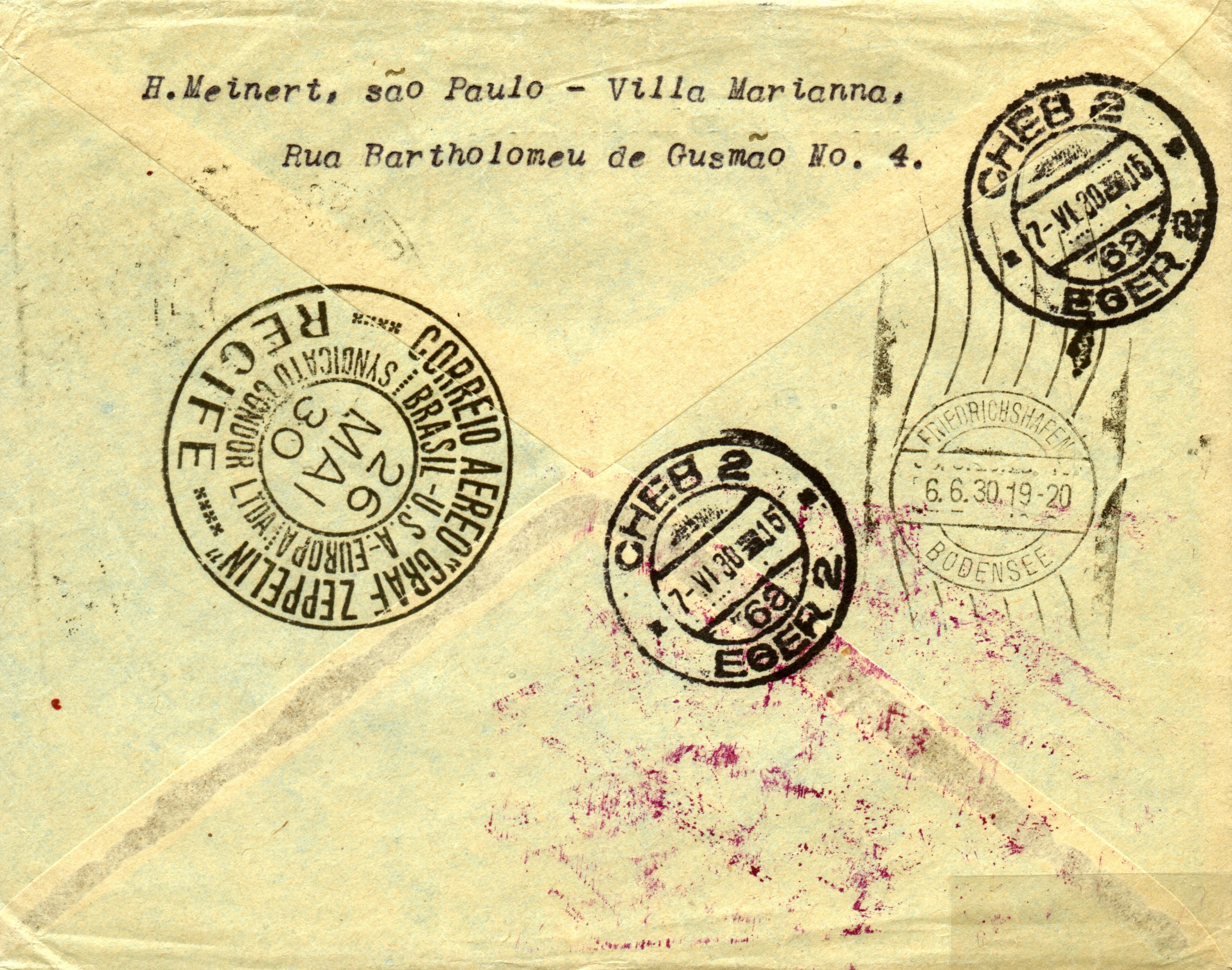 Figure 5: Back of cover from
Fig. 3 with two strikes of Eger cancellations
Figure 5: Back of cover from
Fig. 3 with two strikes of Eger cancellations
Now we come to two different aspects that could be of interest for collectors of Sudetenland:
Address: Maybe I'm being too dumb, but considering the sensibilities of both ethnic groups (at least as was later conveyed by Nazi propaganda), I find it interesting that the address carries only the German name of the destination (Olmütz) instead of Olomouc, or both, a sign of tolerance. This especially true when you consider that Olmütz was never a part of the Sudetenland, and even under the Nazis, was a part of the so-called Bohemia and Moravia Protectorate.
Czech Cancels: Now to one of the most intriguing aspects of these covers. One can, I think correctly, assume that both covers arrived at Friedrichshafen together and then went on their journey to Czechoslovakia via train. The airmail fee paid was only for the Zeppelin part, and the Brazilian stamps covered strictly surface mail. But somehow one cover ended up being back canceled in Eger/Cheb (which was in the Sudetenland) whereas the other didn't. Note that the cancel is bilingual (Fig. 6). Was Eger the "entry point" for German mail to Czechoslovakia? Was the mail separated for the different cities here, or just for the "German" names? This is where a member who collectors this area can better answer these questions.
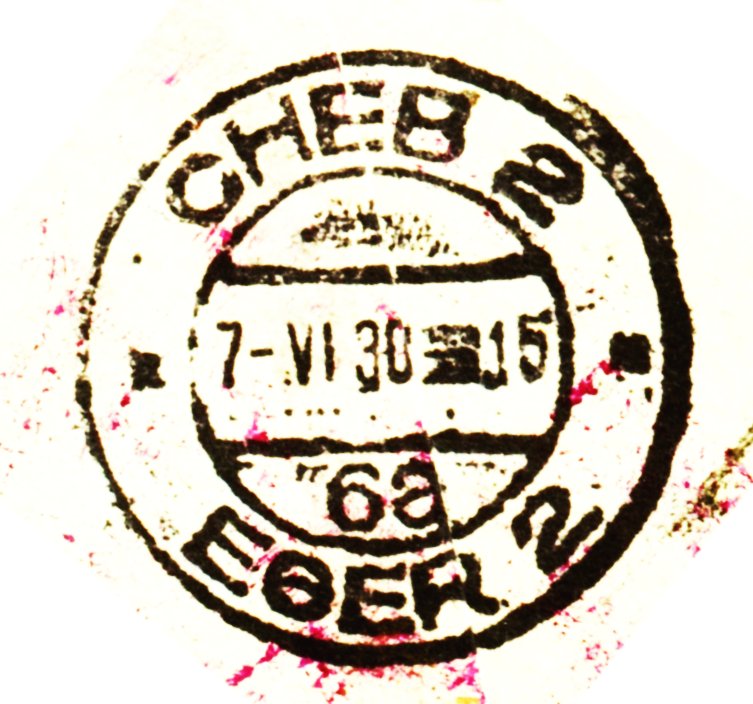 Figure 6: Enlargement of
Eger bilingual cancellation
Figure 6: Enlargement of
Eger bilingual cancellation
Also, another possibility is that both covers traveled together the whole route, but only one received the Eger backstamp. If this happened oftener, it would have consequences for the collectors of Zeppelin covers to some exotic destinations. I. e. Lack of a Czech backstamp doesn't necessarily mean the cover didn't really get there. This fact is demonstrated by two picture postcards (Fig. 7 and 8) sent from Porto Alegre by two different persons to the Northeast sector of the Sudetenland, right above Olmütz.
.
Four simple, straight forward covers with lots of interesting aspects and lots of unanswered questions. Yet only one has an indication of the routing/hand off of the mail. Just the thing for philatelists.
References:
/1/ initial version appeared as Dr. Artur M. Knoth: Zeppelin Letters to Czechoslovakia; German Postal Specialist LIII(1), 22 (January 2002)
/2/ Drawing derived from the original in Hans-Henning Gerlach: Michel-Atlas Zur Deutschland-Philatelie; p. 96 (Schwaneberger Verlag, Munich 1989)
/3/ Artur Knoth: Condor do Brasil Zeppelin Covers on the 1st Pan Am Zeppelin Flight of 1930 : the Rate Samba :; FFE #8, 127 (2005)